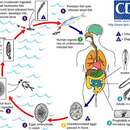en
names in breadcrumbs


The cestode (tapeworm) Diphyllobothrium latum (Broad Tapeworm or Fish Tapeworm) is the largest human tapeworm, sometimes exceeding 10 m in length. In the human intestine, it may live for over two decades. Transmission to humans occurs via the consumption of infected fish. Several other Diphyllobothrium tapeworms have been reported to infect humans, but less frequently (these include D. pacificum, D. cordatum, D. ursi, D. dendriticum, D. lanceolatum, D. dallliae, and D. yonagoensis). The familiar pork and beef tapeworms are in a different genus, Taenia (Taenia solium and Taenia saginata, respectively).
Immature eggs of D. latum are passed in feces from the definitive host (i.e., the host harboring adults, or "final" host). Under appropriate conditions, the eggs mature (after approximately 18 to 20 days) and yield oncospheres (first stage larvae), which develop into coracidia (swimming larvae that attract potential first intermediate hosts). After ingestion by a suitable freshwater crustacean (the copepod first intermediate host), the coracidium develop into procercoid larvae. Following ingestion of the copepod by a suitable second intermediate host, typically a minnow or other small freshwater (or, possibly, anadromous or marine fish), the procercoid larvae are released from the crustacean and migrate into the fish flesh, where they develop into plerocercoid larvae (spargana). The plerocercoid larvae are the infective stage for humans. Because humans do not generally eat undercooked minnows or similar freshwater fish, these do not represent an important source of infection. However, these small second intermediate hosts can be eaten by larger predator species such as trout, perch, and walleyed pike. In this case, the plerocercoid can migrate to the musculature of the larger predator fish and humans can acquire the disease by eating these later intermediate infected host fish raw or undercooked. After ingestion of the infected fish, the plerocercoids develop into immature adults and then into mature adult tapeworms, which will reside in the human host's small intestine. The adults of D. latum attach to the intestinal mucosa by means of the two bilateral grooves (bothria) of the scolex (the anterior part of the tapeworm that is specialized for attachment to the gut wall of the host). The adult tapeworms can exceed 10 m in length, with more than 3,000 proglottids (the bisexual reproductive units strung along the length of the body, which in most cestodes each represent a single worm segment). Immature eggs are discharged from the proglottids (up to 1,000,000 eggs per day per worm) and are passed in the feces. Eggs appear in the feces 5 to 6 weeks after infection. In addition to humans, many other mammals can also serve as definitive hosts for D. latum. Most Diphyllobothrium species exhibit fairly low host specificity as adults, suggesting that the natural hosts of this parasite could be carnivorous mammals or even fish-eating birds.
Infection by D. latum is known from the Northern Hemisphere (Europe, states of the former Soviet Union, North America, Asia) and Uganda and Chile. Freshwater fish infected with Diphyllobothrium larvae may be transported to and consumed in geographic areas where active transmission does not occur, resulting in human diphyllobothriasis. For example, cases of D. latum infection associated with consumption of imported fish have been reported in Brazil.
(Centers for Disease Control Parasites and Health Website; Scholz et al. 2009 and references therein)
In the early 1970s, diphyllobothriosis was estimated to affect 9 million people globally in Europe, Asia, and North America. A more recent estimate indicated that 20 million people are infected worldwide, although infection appears to have declined in some regions and increased in others. Scholz et al. (2009) provide a recent broad review of the biology and epidemiology of D. latum. (Scholz et al. 2009 and references therein)